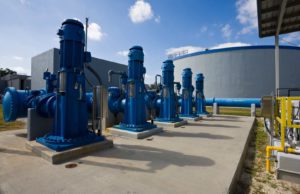Energy consumption and energy management are key focuses for industrial process and utilities companies as they are some of the biggest energy consumers. Most people aren’t aware that up to 40% of the price of water actually stems from the cost of the energy used to treat and deliver the water, and that our convenient access to this water is thanks to the work of a system of electric motors and pumps (which consume energy).
Variable speed drives that are services oriented have the all-important energy management services embedded in their core offer, and can set a new energy performance standard for the operation of electric motors and pumps. These drives are designed to leverage and integrate into the Industrial Internet of Things (IIoT), and can drastically reduce the energy consumption of heavily energy reliant processes.
Services oriented drives are the next generation of variable speed drives
IIoT facilitates the interconnection of smart devices, and services oriented drives have the three main characteristics of smart devices:
1. They carry out their traditional role as variable speed drives, controlling pumps and motors.
2. They are natively connected to the system, with an embedded Ethernet connection.
3. They include smart services related to energy management.
And, these embedded smart services cover the four steps for energy management:
1. Measure energy consumption
2. Monitor key performance indicator
3. Improve the system’s energy performance
4. Implement asset management to achieve lasting performance
Embedded energy management services
This next evolution of variable speed drives includes a highly accurate power measurement function (accuracy is less than 5%) that makes it possible to continuously monitor the energy consumption of each motor or pump in an installation. Traditionally, an installation would be monitored using a power meter that would measure overall consumption, either for the complete installation or for a functional unit. When a drift in energy consumption occurred, however, the operator would have to try to identify where the drift was happening and why. This took time and cost money.
With services oriented drives in an installation, the operator can monitor the energy consumption in real time, and if they detect a drift on a motor, pump, or fan, they can react immediately. The energy consumption and drift data can be sent directly to any supervision system as the information is available in an open standard format. It can also be accessed through the embedded web server of the device.
By connecting hydraulic measurements to services oriented drives, the operator can monitor in an embedded smart graphic way the system operating point and react more easily to graphs than on data.
Unlocking system energy efficiency with system performance service
The efficiency of a pumping system depends on the use of the pump. Each pump has specific characteristics called “pump curves” (head vs. flow curve is one of them) which are provided in a datasheet from the manufacturer. A pump can be compared to a car engine which is most fuel efficient when it is driven in the ideal RPM range and less efficient when used outside this range. At a system level, the pump efficiency is also dependent on the hydraulic system at which it is connected, as the car efficiency is linked to the inclination of the road.
Services oriented drives take a pump’s characteristics into account when they are configured, and follow its efficiency levels using dedicated firmware algorithms. For applications like water level control, the algorithms can ensure the pump is always operated at the system’s “Best Efficiency Point” (the working point at which the system will consume the least amount of energy).
By combining integrated power measurement and the pump’s characteristics, the services oriented drive provides a specific energy consumption KPI. This KPI, in kilowatt hours per cubic meter (kWh / m3), makes it possible to track the system’s overall energy efficiency. With this system performance service, operators can monitor and manage the energy performance of every pump in their installation in real time.
Asset management services for long lasting energy performance
In order to deliver energy savings with energy and system performance services, the system needs to last. Services oriented drives embed asset protection services and enable condition based maintenance for pumping operations.
By knowing the pump’s characteristics, the services oriented drive can make sure that the pump is not running in conditions that would be damaging to it. The drive will ensure that the pump does not enter cavitation or low flow mode, both very harmful to the asset. It also allows condition based maintenance, meaning that the operator will know, in real time, the exact efficiency of the pump and be able to choose the optimal time to trigger maintenance operation by comparing the cost of the energy lost against the cost of the maintenance.
The services oriented drive is an important evolution of variable speed drives, with a clear focus on effective energy management. It is unique in its ability to bring both energy efficiency and energy management services in order to run growing operations with less energy.




Conversation
here I found some really interesting information about water.
Thanks for your interest in this post.
François.